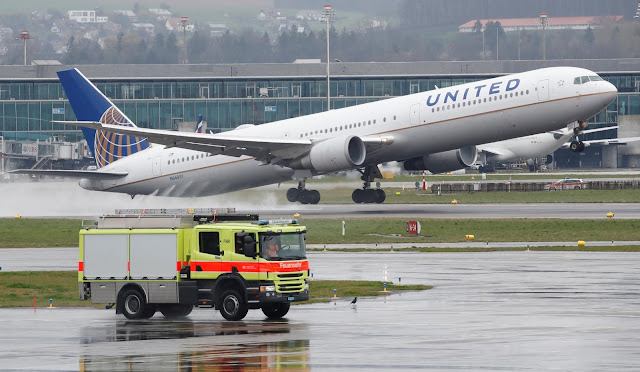Global airlines are re-routing flights to avoid Iran-controlled airspace over the Strait of Hormuz and Gulf of Oman, they said on Friday, after the U.S. aviation regulator barred its carriers from the area until further notice.
 |
| A vehicle of the airport rescue and firefighting services stands in front as a Boeing 767-400ER aircraft of United Airlines takes off from Zurich airport, April 9, 2019. REUTERS |
Thursday’s emergency order from the U.S. Federal Aviation
Administration (FAA) came after Iran shot down a high-altitude U.S. drone with
a surface-to-air missile, sparking concerns about a threat to the safety of
commercial airlines.
The downing of the unarmed
Global Hawk drone, which can fly up
to 60,000 ft (18,300 m), was the latest in a series of incidents in the Gulf
region, a critical artery for global oil supplies, that included explosive
strikes on six oil tankers.
According to flight tracking applications, the FAA said, the
nearest civil aircraft was operating within about 45 nautical miles of the
unmanned aircraft when it was shot down.
“There were numerous civil aviation aircraft operating in the
area at the time of the intercept,” the FFA said, adding that its prohibition
would stay in place until further notice.
Hours earlier, United Airlines suspended flights between New
Jersey’s Newark airport and India’s financial capital of Mumbai following a
safety review.
Emirates Airlines, Malaysia Airlines, Australia’s Qantas Airways
Ltd, Singapore Airlines Ltd, Germany’s Lufthansa, British Airways and KLM of
the Netherlands said they were re-routing flights to avoid the area.
‘THREAT
IS REAL’
The FAA said it remained concerned about the escalation of tension
and military activity in close proximity to high-volume civil aircraft routes
as well as Iran’s willingness to use long-range missiles in international
airspace with little or no warning.
In July 2014, Malaysia Airlines Flight MH17 was shot down by a
missile over Ukraine, killing all 298 on board, prompting carriers to take more
steps to uncover threats to their planes.
But concerns persist over inadequate government intelligence
sharing and a reluctance by countries involved in conflicts to divulge information
or sacrifice overflight fees by closing their skies, according to safety
experts.
The U.S. ban does not apply to airlines from other countries,
but OPSGROUP, which provides guidance to operators, said carriers globally
would take it into consideration.
“Since MH17, all countries rely on advice from the U.S., the
U.K., France and Germany to highlight airspace risk,” it said.
“The threat of a civil aircraft shootdown in southern Iran is
real,” it added.
Restricting airspace complicates airline efforts to keep routes
running in a region where airspace is already congested, in part due to ongoing
conflicts which have made it unsafe to fly over some countries.
At 0820 GMT on Friday, flight tracking website Flightradar24
showed Qatar Airways flights in the area barred to U.S. carriers.
On Monday, before the drone was shot down, Qatar Airways Chief
Executive Akbar al-Baker told Reuters the airline “has a very robust plan B for
any eventualities, including if there is a conflict in our region.”
Qatar Airways did not respond immediately to a request for
comment on Friday on whether it had introduced new measures since the drone was
shot down.
Etihad Airways, which was flying over the area earlier,
according to FlightRadar24, said it was monitoring the situation and had
adopted contingency plans.
“We will decide what further action is required after carefully
evaluating the FAA directive,” the Abu Dhabi-based airline said. “We are
working closely with the United Arab Emirates General Civil Aviation
Authority.”
Emirates, which was also flying over the area earlier on Friday,
did not respond immediately to a request for comment.
FLIGHTS SUSPENDED
United said it had suspended its flights to India through Iran
airspace after a “thorough safety and security review,” but did not say how
long the suspension would last.
A United spokesman said customers flying from Mumbai to Newark
would be booked on alternative flights back to the United States.
“We continue to explore all our options and remain in close
contact with relevant government authorities,” he added.
A Lufthansa spokesman said the company’s planes had been
avoiding the Strait of Hormuz since Thursday. He added that Lufthansa had
extended the no-fly zone over Iran on Friday, without being more specific. The
airline is still serving Iran’s capital, Tehran.
Netherlands flag carrier KLM was no longer flying over the
Strait of Hormuz, a spokesman said on Friday, while British Airways said it would
adhere to the FAA guidance and use alternative routes.
Malaysia Airlines said it was avoiding the airspace, which it
had previously used on flights between Kuala Lumpur and London, Jeddah and
Medina.
“The airline is closely monitoring the situation and is guided
by various assessments, including security reports and notices to airmen,” it
added.
Qantas said it was adjusting flight paths to avoid the Strait of
Hormuz and Gulf of Oman until further notice. Singapore Airlines said some
flights might require longer routings to avoid the area.
On Thursday, two other U.S. carriers, American Airlines and
Delta Air Lines, said they did not fly over Iran. Japanese carriers Japan
Airlines Co Ltd and ANA Holdings Inc also said they did not fly over the area.
- Reuters











No comments:
Post a Comment